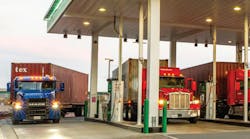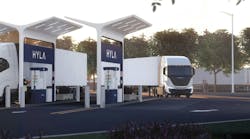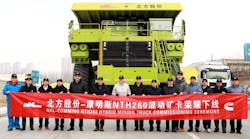To make Tier 4 diesels perform to EPA standards, off-road equipment design engineers and manufacturers have had to tighten the cause-and-effect integration between components such as hydraulics, cooling and fuel systems. Tier 4 engines are now an interdependent network of systems in which each component’s performance depends on and complements the others with minute margins for error. The relationship of these sophisticated parts and systems is changing mechanics into technicians.
The condition-based maintenance (CBM) methodology—based on a “monitor it, measure it, evaluate it, manage it” model—has been knocking around shops and management offices for a while now. As an add-on to regular scheduled preventive maintenance, CBM helps head off downtime on the technology-rich Tier 4 machines. CBM helps contain service hours and parts inventories by tracking and evaluating when a consumable item, such as a filter or fluid, has more useful hours even if it has reached its scheduled PM date. CBM monitors and manages the Tier 4 components as well as the machine as a whole. This holistic approach is especially advantageous when dealing with systems that are required to run full-out, hot, and with zero tolerance for inconsistencies or soot. Ideally, the CBM goal is to evaluate the sum health of the system’s parts so that repair or replacement maintenance is done when necessary and well before downtime.
Telematics Speak the Diesel Dialect
The three-way communication between the equipment user, the equipment dealer, and the equipment itself is becoming clearer as Tier 4 machines find their voice in their telematic systems. For those fleets that use a CBM program, being able to listen to what the diesel is saying can save time and budgets.
“CBM is somewhat observational,” says Ken Calvert, director of machine support systems for Komatsu America. “KOMTRAX data help give the owner a heads-up, telling him ‘you might want to look at this.’”
Unlike a fluid or filter analysis that reports symptoms after hours, telematics present realtime operations observations. Then, depending on the sophistication of the system, the telematic program narrows down the cause and location of the issue. With that, the operator receives a cautionary nudge toward noticing something is up or an alert that demands immediate action.
The ability to track a machine’s behavioral trends allows the fleet’s maintenance department to develop a history on a new machine, especially helpful with new technology. When the machine is sent to the dealer for deeper maintenance or repair, the dealer’s technicians see a prequalified account of the machine’s current condition, its recent operating conditions, and symptoms.
Komatsu was an early adopter of electronic monitoring and was the first to include a telematics system as a standard, free feature, Calvert says. Komatsu’s fourth-generation KOMTRAX system has grown from its original location and hours monitoring system to an operation data and managing service that assesses and records everything the machine does.
As the telematics data are compiled, trends specific to that machine become apparent and give additional justification to maintenance decisions that are based on observing conditions of a component.
Calvert says telematics can detect more than 5,000 alert codes: far more than the operator can watch for while working.
“Perhaps the sensor detects overheating, acknowledges the data, makes an assessment, and displays a caution or alert to the operator. At the same time, the incident is recorded in the owner’s and dealer’s digital files. This data would be an indicator to the technician to look for the cause of the overheating and monitor the condition of secondary components that may have been affected by the incident.
“If the owner had had some issues between his PM intervals, the alerts would be an indication to do a coolant analysis to determine if early maintenance was required,” he says. “The data would also suggest checking the condition of secondary systems that may have been affected.”
Calvert cautions that human interaction in Tier 4 CBM cannot be undervalued.
“The last thing any of the OEMs want is for owners to stop doing daily walk-arounds and start relying only on the machine’s electronics,” he says. “There is no replacing the human interaction with technology. The daily check is still something best done by a human.”
Condition-based maintenance on Tier 4 engines is less about watching how a particular component wears, and more about paying attention to how that part’s performance affects the other systems that make up the entire piece of equipment. A Tier 4 engine depends on the relationships of its parts, and those parts must work well at two levels: the primary task for which they are designed and the secondary support they need to supply to other parts of the machine.
“The engines didn’t change a lot going from the Tier 3 to the Tier 4 series as far as regular maintenance goes,” says Dave Hahn, hauler/loader/power train manager for Volvo Construction Equipment. “The differences now are Tier 4 engines have new equipment such as SCR and/or EGR systems that include additional filters and injectors that require maintenance. The OEMs have had a choice as to which emissions technologies they use, so Tier 4 engines can come in several different configurations depending on the machine and the manufacturer. With this in mind, Volvo is keeping equipment maintenance easy and extending that convenience to the additional Tier 4 emissions components.”
And while basic diesel DNA is the foundation for current heavy-equipment engines, their electronic machine control modules and telematics systems now jack up the Tier 4 engine’s performance, in some cases taking over adjustments that might have been made with a wrench at the hands of a diesel technician. With much of the Tier 4 engine operation decisions made by a circuit board, out of the technician’s control, diagnosing where a repair or maintenance situation originates requires diagnostic tools that provide a different type of observation. CBM diagnostic tools give the technician the ability to observe conditions that aren’t available by popping the hood and wiping a dipstick.
Observing what can’t be seen is where fluid and filter analysis works for CBM. Oil analysis will show a change in viscosity and indicate if the cause is due to soot, excess heat, unburned fuel or incompatible additives. The oil can be screened for water contamination that might be due to poor fuel quality or a faulty fuel-filtering system. Fluid analysis taken from the transmission can show wear based on the number and size of debris particles found in the sample. Taking that observation one step further to determine the makeup of the particle—metal, chemical, bio, hybrid—will indicate where the engine is starving for lubrication. For example, a large amount of metal debris could point to irregular heat issues that may be causing spalling or pitting. Similarly, filter analysis will show if there is a foreign contaminant that could be causing clogs or poor performance. Particles in hydraulic filters can indicate pump wear or contamination at entry points. Debris in dry element filters can indicate excessive metal-on-metal wear. Water in a fuel filter begs the question of how fuel has been stored. A fleet manager can then take the information from these reports to create a wear-debris baseline for future samples.
Tracking the performance of the Tier 4’s inner workings is a key benefit of CBM. Diego Navarro, a CBM expert and global fleet management solution manager with John Deere, says monitoring the condition of each system’s moving parts, as well as the vehicle’s collective performance, is vital.
“We are asking so much more of the Tier 4 machines,” he says. “We want power, clean exhaust, fuel economy, and easy maintenance. And, as we go to Tier 4-Final there will be even more elements that need care.”
The additional emissions control components may create more potential leaking points in the engine, Navarro says. Fluids from one part could contaminate another, but a visual inspection may not find the source. Fluid analysis then becomes a key diagnostic tool. Navarro says that correct interpretation of an oil analysis will pinpoint the leak.
“You may not be able to see evidence of an inner coolant leak by observing the machine’s exhaust,” Navarro says. “But you will see a higher level of iron in the oil sample analysis, which is an excellent indicator of coolant leaking from the EGR and being consumed in the combustion chamber. If the sample shows copper, sodium and potassium, you may have a failed oil cooler.”
The youth of Tier 4 engines is another excellent reason to use CBM procedures. Since Tier 4 machines are still in their honeymoon hours, technicians don’t have years of machine history to call on when they are trying to find the cause of downtime. Tracking and analyzing a new machine’s performance in various applications, both by individual machine and by broader equipment category, creates a baseline performance trend that can be used to develop more individualized preventive maintenance schedules and forecast future service schedules and budgets.
As diesel engine technology is evolving, maintenance practices need to change, too. Navarro gives this example:
“Tier 4 engines have less tolerance to contamination,” he says. “In the past, we managed to survive with dirty fuel. We just changed the filter and kept on going. Today’s engines are running hotter, we are squeezing more performance out of them, and they are designed to run at full power. To do this, we are injecting fuel at a rate 10 times higher than 10 years ago. The fuel injectors are made of a very hard alloy but are more prone to wear now because of the high pressure they experience.”
Navarro says the industry is continually improving the fuel injectors with new technologies such as spray patterns, but it is necessary for fleet asset managers to monitor the condition and handling of their fuel well before it reaches the injectors to ensure that the condition of the fuel matches the technology and minimizes potential wear.
“Part of the problem is that contractors are handling fuel like they did yesterday, and that can cause fuel contamination and engine wear,” Navarro says. “They must monitor the conditions of how the fuel is transported and stored so they can eliminate contamination. This is especially important, because even ULSD fuel has properties that can aggravate the Tier 4 injectors. ULSD fuel has a tendency to leave behind carbon in some applications. You have to clean the Tier 4 injectors more often and with a much stronger solvent, whereas earlier machines required cleaning less frequently.
“You have to change your maintenance with the technologies to make them work.”





